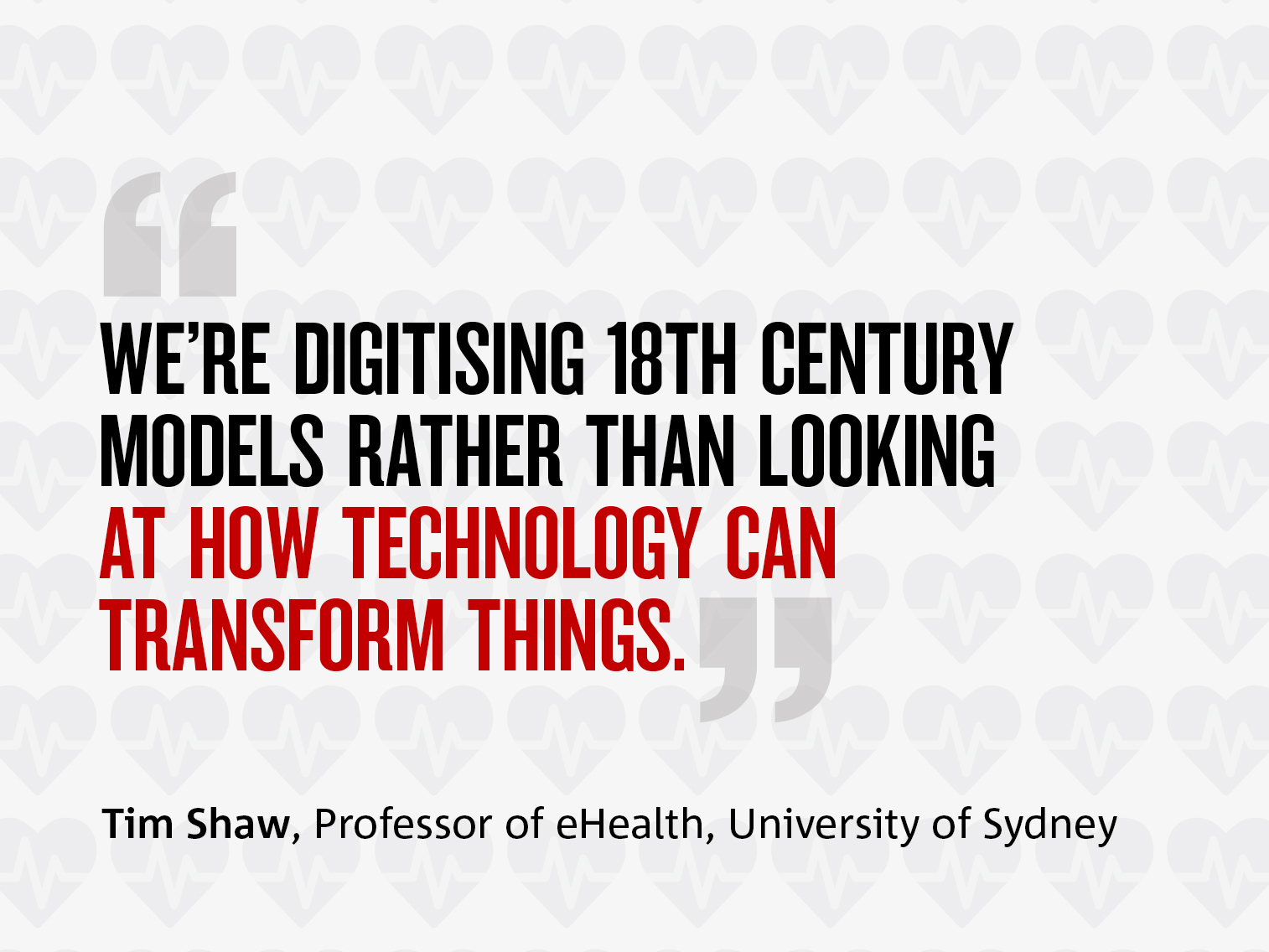Confidence and Conditions Lift


Insight
Around the world, technology is transforming patient care. So why is Australia slow to follow suit?

What’s stopping patients from getting the personalised healthcare they want? We take a look at the barriers to true transformation – and how something as low tech as a text message could save lives.
Forgotten to fill a prescription? If you lived in the US, there’s every chance you’d get a text message asking whether there’s a problem and if you need help. You could also receive text reminders to take the medication, attend screenings and even adopt healthy behaviours.
“One of the American companies I work with is already sending out 1.5 million fully automated but complex messages every day,” says Tim Shaw, the University of Sydney’s inaugural Professor of eHealth and also Director of Research at the federally funded Digital Health Cooperative Research Centre.
“It isn’t that their technology is way ahead of ours – we have it here today. We’re being hampered more by culture and government funding models than technology.”
Shaw describes Australian healthcare as “high tech but not digital”.
“We’re stuck in the place of a thousand pilots, when what we really need is new models of healthcare,” he says. “At the moment we’re effectively digitising 18th century models rather than looking at how digital technology can transform the way we do things.”
Shaw sees fundamental problems with the environment needed to support a true digital transformation.
“You might have a complex and highly technical surgical procedure but your discharge summary will be written on a piece of paper,” he says.
From his work with cardiac rehabilitation and secondary prevention, he knows that people who’ve had a heart attack are far more likely to survive, and far less likely to be readmitted to hospital, if they attend a follow-up program – but only about 30 per cent of former patients are participating.
“You can get a reminder from your hairdresser, but you won’t necessarily get a reminder for free or low-cost activities that could help save your life,” Shaw says.
He adds that much of the low-hanging fruit is relatively low-tech.
“Our health system is still built around acute services and 15-minute consultations with a GP or a specialist, but the fastest-rising costs are related to the increasing incidence of chronic disease.
“We’re still at the very beginning of our journey towards using technology for management and prevention. We tend to focus on the killer intervention and the really high-tech innovation when we could have far more impact at a population level by getting some of the fundamentals right, such as using messaging to help manage people’s blood pressure.”
Reminders and suggestions are just one aspect of more consumer-centric model of healthcare.
“I think people are also looking for greater convenience and transparency,” says Kate Galvin, Customer Executive of NAB Health.
“As consumers become accustomed to easy digital transactions, with everyone from their bank to online retailers, it’s natural they’ll expect the same from their healthcare providers. They’re also gaining more insight into their health through wearables and apps on their phones, and I think this will help the push to a more personalised approach.”
New tools are already improving the patient-doctor experience and saving practitioners’ time. For example, NAB recently partnered with HealthShare, the developers of the BetterConsult pre-consultation tool.
“This captures relevant patient information such as their symptoms and current medication, then translates that into notes the doctor can read and review before the appointment,” says James Beilby, Head of Product at HICAPS. “As a result, the doctor has more time to discuss treatment options and answer patients’ questions, and it also saves them from the drudgery of taking notes.”
NAB is also looking at ways to make it easier for patients to find out how much various treatments will cost.
“Consumer-centric healthcare is about control, and that includes knowing in advance how much you’re likely to have to spend,” Beilby says.
Given the speed with which technology is developing, it’s surprising how slowly change is progressing. “I predict it will be three to five years before we see genuine transformational shifts,” Shaw says. “On the horizon, I think governments will continue to look into funding new models of care supported by technology,” he says. “A key block at the moment is our inability to link primary and acute data, and I think we’ll have some real breakthroughs in this area. I also hope better legal and legislative structures will be developed within the next two years. The governance and ethics frameworks we currently have for data access and usage are not fit for purpose.”
NAB is also considering new ways to support healthcare providers, such as funding integrated care.
“Integrated health hubs will include a dietitian, physio and pharmacist along with GPs,” Galvin says. “These one-stop shops can help manage the treatment of chronic conditions as well as preventative health.”
Shaw also believes that consumers and healthcare providers will become more accepting of change.
“Health professionals are, quite rightly, a conservative group who want to see evidence that something new is worthwhile, and more evidence is emerging every day,” he says.
“We also need new ways of working with communities to ensure they feel comfortable we’re using their data in positive ways.”
Tim Shaw suggests three ways to effect transformation
© National Australia Bank Limited. ABN 12 004 044 937 AFSL and Australian Credit Licence 230686.